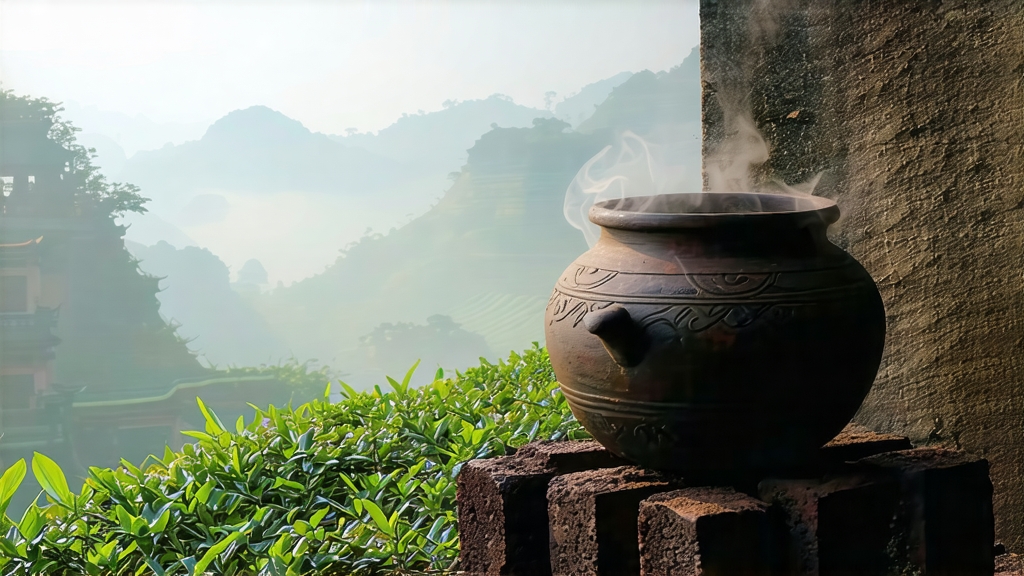
Tucked away in the humid, karst-pitted mountains of southern China’s Guangxi Zhuang Autonomous Region, Liu Bao cha has spent four centuries quietly fermenting its way into the hearts of dock workers, caravan muleteers, and, more recently, global tea connoisseurs. While Pu-erh grabs the headlines, Liu Bao is the sleeper hit of the dark-tea family: smoother, deeper, and laced with the scent of damp forest floor, star anise, and the faint sweetness of dried longan. To understand Liu Bao is to follow the West River downstream from the highlands of Wuzhou to the trading wharves of Hong Kong and, ultimately, to the mahogany-lined tearooms of Kuala Lumpur, where old Chinese grandfathers still brew it in tiny porcelain pots while recounting stories of tin mines and rubber estates.
Historical currents
Liu Bao takes its name from the administrative village of Liu Bao in Cangwu County, Wuzhou Prefecture. During the Qing dynasty’s Yongzheng reign (1723–1735), the imperial court designated the town as one of six major tea-collecting depots for the “tea tax horse” exchange with Central Asian traders. Compressed into 40-kilogram bamboo baskets, the tea traveled by coolie and river raft to Guangzhou, then by clipper ship to Southeast Asia. The sweltering holds of junks acted as mobile incubators, triggering a secondary, microbial fermentation that softened the leaf and darkened the liquor. By the time the baskets reached Singapore or Penang, the tea had morphed from a coarse mountain leaf into a velvety, digestive tonic prized by miners and dockers who lived on rice, salt fish, and little else. In 1801 the Jiaqing Emperor listed “Cangwu Liu Bao” as a gong cha (tribute tea), sealing its reputation across the empire.
Varietal microcosm
Strictly speaking, Liu Bao is a place-name style rather than a single cultivar, yet two leaf architectures dominate the modern market. The traditional “big leaf” (Da Ye) strain, a close cousin of Yunnan’s Da Ye Zhong, yields a broad, leathery blade high in polyphenols and methyl salicylate, the compound responsible for Liu Bao’s signature cooling, almost medicinal finish. Since 1985 clonal gardens have planted the “small leaf” (Xiao Ye) Wuzhou Qunti cultivar, which ripens faster, produces a sweeter nose, and tolerates the region’s blistering summers. Purists insist that only the former develops the deep betel-nut and camphor notes after fifteen years of aging; pragmatists reply that the latter reaches drinkability in half the time. Both, however, must be grown within the 24,000-hectare microclimate defined by the Gui River basin to earn the protected “Liu Bao” stamp issued by the China Geographical Indications Office.
Crafting darkness
The journey from fresh leaf to aromatic brick is a choreography of moisture, heat, and patience that begins in late April when the mountain air smells of jasmine and approaching rain. Pickers pluck one bud plus the third or fourth mature leaf—the lignin-rich blades that feed the microbes yet to come. After a brief solar withering, the leaves are sent to a 200-year-old factory whose brick walls are blackened by decades of tea dust. Here they undergo “kill-green” in a coal-heated, waist-high wok set to 280 °C for exactly three minutes, hot enough to denature oxidative enzymes but not so hot as to bake the leaf surface. Rolling follows, first mechanically then by foot inside a 1.5-meter bamboo drum lined with jute sacking; the pressure ruptures cell walls, releasing amino acids that later become cocoa and malt flavors.
The critical step—and the one that separates Liu Bao from other dark teas—is the “wet piling” (wo dui). Workers build one-tonne heaps on cement floors, spraying 28 °C river water until moisture reaches 38 %. A quilt of jute and polyethylene traps humidity, jump-starting a microbial rave dominated by Aspergillus niger, Blastobotrys adeninivorans, and a lactic acid bacteria consortium unique to Wuzhou. Every 48 hours the pile is turned, aerated, and re-sprayed; temperature probes must never exceed 65 °C lest the tea turn sour. After 25–30 days the leaf has transmuted from olive green to umber